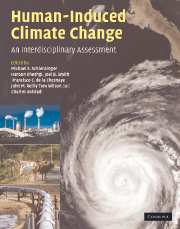Book contents
- Frontmatter
- Contents
- List of contributors
- Preface
- Part I Climate system science
- Part II Impacts and adaptation
- Part III Mitigation of greenhouse gases
- Part IV Policy design and decisionmaking under uncertainty
- 25 Climate policy design under uncertainty
- 26 Climate policy assessment using the Asia–Pacific Integrated Model
- 27 Price, quantity, and technology strategies for climate change policy
- 28 What is the economic value of information about climate thresholds?
- 29 Boiled frogs and path dependency in climate policy decisions
- 30 Article 2 and long-term climate stabilization: methods and models for decisionmaking under uncertainty
- 31 Whither integrated assessment? Reflections from the leading edge
- 32 Moving beyond concentrations: the challenge of limiting temperature change
- 33 International climate policy: approaches to policies and measures, and international coordination and cooperation
- Index
- Plate section
- References
32 - Moving beyond concentrations: the challenge of limiting temperature change
from Part IV - Policy design and decisionmaking under uncertainty
Published online by Cambridge University Press: 06 December 2010
- Frontmatter
- Contents
- List of contributors
- Preface
- Part I Climate system science
- Part II Impacts and adaptation
- Part III Mitigation of greenhouse gases
- Part IV Policy design and decisionmaking under uncertainty
- 25 Climate policy design under uncertainty
- 26 Climate policy assessment using the Asia–Pacific Integrated Model
- 27 Price, quantity, and technology strategies for climate change policy
- 28 What is the economic value of information about climate thresholds?
- 29 Boiled frogs and path dependency in climate policy decisions
- 30 Article 2 and long-term climate stabilization: methods and models for decisionmaking under uncertainty
- 31 Whither integrated assessment? Reflections from the leading edge
- 32 Moving beyond concentrations: the challenge of limiting temperature change
- 33 International climate policy: approaches to policies and measures, and international coordination and cooperation
- Index
- Plate section
- References
Summary
Introduction
The UN Framework Convention on Climate Change (UNFCCC) shifted the attention of the policy community from stabilizing greenhouse gas emissions to stabilizing atmospheric greenhouse gas concentrations. While this represents a step forward, it does not go far enough. We find that, given the uncertainty in the climate system, focusing on atmospheric concentrations is likely to convey a false sense of precision. The causal chain between human activity and impacts is laden with uncertainty. From a benefit–cost perspective, it would be desirable to minimize the sum of mitigation costs and damages. Unfortunately, our ability to quantify and value impacts is limited. For the time being, we must rely on a surrogate. Focusing on temperature rather than on concentrations provides much more information on what constitutes an ample margin of safety. Concentrations mask too many uncertainties that are crucial for policymaking.
The climate debate is fraught with uncertainty. In order to better understand the link between human activities and impacts, we must first understand the causal chain between the two, i.e., the relationship between human activities, emissions, concentrations, radiative forcing, temperature, climate, and impacts. The focus of the UNFCCC is on atmospheric concentrations of greenhouse gases. Although this represents a major step forward by advancing the debate beyond emissions, it does not go far enough. In this paper, we carry the analysis beyond atmospheric concentrations to temperature change.
- Type
- Chapter
- Information
- Human-Induced Climate ChangeAn Interdisciplinary Assessment, pp. 387 - 402Publisher: Cambridge University PressPrint publication year: 2007
References
- 4
- Cited by



